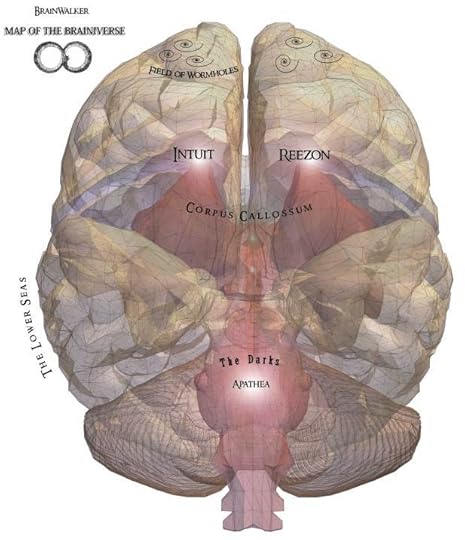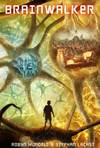Robyn Mundell's Blog: Brainwalker Blog
October 24, 2016
Left, Right, and Center: It’s All In Your Head
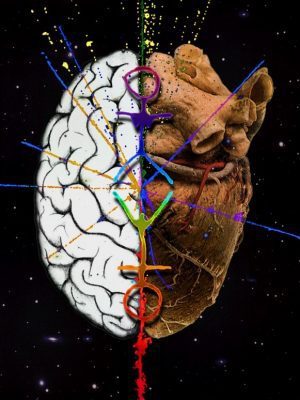
With the enormous amount of political noise assaulting us on a now daily basis, I decided to take a quiet moment, sit down, and think about thinking.
Mostly I’ve been thinking about division. Much has been made about the debunking the theory on brain’s left and right sides, a theory we based our book Brainwalker on. We don’t disagree with the science—as authors, we just see the value of that theory as a metaphor for a bigger picture.
While it is true that we may not have a left brain or right brain governing our actions, we do have what’s known as personality types. Each person has their own preferred mode of thinking and behaving. Carl Jung described them as “rational” (thinking and judging) and “irrational” (sensation and intuition). Some are more comfortable with ideas, others in the realm of experience. Some prefer proof and some prefer dreams. Some prefer poring over details while others jump in and take action. And when stressed or angered, some start making plans, others start making demands.
We fall back on these personality preference as our “default” and to an extent it defines our lives. When confronted by incredibly stressful situations—like school, work, or the loss of a loved one, our current political divide—we turn to these preferences instinctively.
Perhaps this explains why we are unable to convince die-hard fanatics of one side or the other—when confronted, we too easily return to form and bunker down. I find this division easy to see in the current political climate, where citizens are deeply split along political lines.
But given that our personality preferences are choices, we aren’t behold to them. Our minds are malleable. They can and do change over time: when we enter new environments, take on new roles, and form new relationships with people.
Brainwalker is an attempt to show that our divisions exist mostly in our minds. Whether you prefer rational thought or exciting experiences, you still have only one mind. And whether you are on one side or the other of the political spectrum, it’s still one nation—the only one we got at that.
If would wanted to, we can open doors and improve relations with other people by understanding their personalities—including their mode of thinking and their preferred style of communication—instead of simply imposing our own.
It takes effort, yes. But I say our lives will certainly become richer for it.
The post Left, Right, and Center: It’s All In Your Head appeared first on Brainwalker.
August 31, 2016
Smashing Atoms into Wormholes

It’s not much of a spoiler to say that the real action in Brainwalker starts when Bernard opens the hatch on a particle accelerator and goes through a wormhole into the Brainiverse. The question is just how plausible is it?
Before answering the question, it’s important to remember the words of the Mythbusters, “Don’t try this at home.” Getting caught up in a particle accelerator is one of the worst things that could happen to anyone; but that doesn’t make the physics any less interesting.
The particle accelerator in Brainwalker is based on the Large Hadron Collider, which is the world’s largest “atom smasher,” built at CERN near Geneva in Switzerland. Like the LHC, the particle accelerator in Brainwalker is seventeen miles long. It has to be that long because the proton beam moves so fast: 99.9999991% of the speed of light to be exact. At that speed you could bicycle to the Moon in less than two seconds.
Because it’s a collider, it actually uses two beams, one going in each direction. The LHC uses superconducting magnets to accelerate clumps of protons to near light speed, and then more magnets to cross the streams. The particles smash each other to bits, and the scientists look at the fragments. The harder they hit, the more energetic the fragments, and the better chance you have of finding something new.
Unfortunately for those of you wanting to copy Bernard, you can’t just open a hatch on the LHC and hop in. That’s a good thing, too. First, there’s no air inside the collider; it would stop the protons. Second, the superconducting magnets have to be kept very cold to work; about 456 degrees below zero. That’s much colder than even outer space. If you opened a hatch you’d get blasted by radiation and frozen by temperatures more than 325 degrees colder than the coldest temperature ever recorded in Antarctica.
So, opening the hatch is a no-go, but what about the wormholes?
Well, that’s a big maybe, which makes sense since nobody knows if wormholes actually exist.
What we do know about are black holes, and several theories say that a big enough particle accelerator could create tiny quantum black holes. Since some theories also say that a black hole might be one end of a wormhole, then maybe a big enough particle accelerator could create a wormhole. It would have to be more powerful than the LHC, but there’s nothing in the story that says the one where Bernard’s dad works isn’t that powerful.
Wormholes themselves are pretty neat. Imagine a piece of paper (that’s space-time) folded together so that the ends touch. A wormhole would let you jump directly from one end to the other so that you could skip going the length of the paper. Also, because wormholes fold space-time, not just space, a wormhole can even work as a time machine connecting the future or the past. One jump could take you anywhere, or even anywhen.
So while you can’t jump into a particle accelerator, the basic idea of a powerful one creating a wormhole is not that far-fetched. The catch is that you’re not likely to be as lucky as Bernard if you encounter one.
The post Smashing Atoms into Wormholes appeared first on Brainwalker.
July 19, 2016
Origins of the Myth of Right and Left Brained People

Everyone knows that right-brained people are more artistic and creative, while left-brained people are more logical and scientific. The only problem is that like many other things that “everyone knows,” this is a myth. It’s an attractive myth, it’s easy to explain and even easier to understand, but like many other such beliefs it is so much simpler than the truth that it’s utterly wrong. So why use this myth in Brainwalker?
Like many other such ideas, this myth of brain “handedness” is a very old one. Nobody knows who first came up with the idea, but it goes back to at least the 1800s. As near as anyone can tell, it first took root when researchers noticed that patients with similar head injuries had similar problems. Specifically, they discovered that people with injuries in the left hemisphere developed language problems, while those with injuries in the right hemisphere were more likely to have problems with spatial knowledge.
The next leap forward came in the 1960s, when doctors started severing the corpus callosum as an epilepsy treatment. As scientists studied these patients, they discovered that they sometimes acted as if they had two completely different and separate minds. For example, a person might be asked a question and say one answer, but write another. This led to the theory of right or left brain dominance as demonstrated by Floyd and Bernard in the story.
Unfortunately, the brain didn’t follow the theory. Initially, scientists predicted that if one hemisphere was truly dominant, then it would be better developed. Artists would have more and stronger connections in the right brain, scientists in the left. The brain doesn’t work that way: it’s not so much the different areas that control things like creativity, but the connections. It is true that the left hemisphere controls the right side of the body, and the right hemisphere the left side, but that’s as far as it goes. Even when localized areas control specific functions, it’s not as cut and dried as the simple explanation would have it.
When it comes to thinking, both sides are in it together.
Getting back to the question of why we would use the idea in Brainwalker, the basic answer is that it provides a basic conceptual framework for more important ideas. Yes, the fundamental idea that people are either left or right-brained is simplistic and inaccurate, but there really are creative people like Bernard, and analytical types like his father Floyd. Using the commonly understood terminology makes it easier for readers to follow the story. After all, most people have taken tests or been told they’re either left-brained or right-brained.
Besides, this kind of categorization isn’t all bad, either. If you can identify your own strengths and weaknesses, you know what to work on. The problem only comes in when you use these judgments as an excuse not to try.
Not trying is actually worse than it sounds because of the way the brain depends on connections. When you learn new things, you build new connections in the brain, and you can not only get better, but also rewire your brain to make things easier. You can actually see this in action by reading Brainwalker.
Floyd’s focus on logic and analytics is reflected in his brain, weakening the areas used for creative thought and strengthening those used for rote repetition. At the same time, Bernard is more focused on raw creativity until he is trapped in Floyd’s brain and forced to make use of his logical faculties. As Bernard travels through the Brainiverse, he builds new connections in his brain, strengthening his analytical abilities, or “left-brain.”
That is the real lesson of Brainwalker: that we aren’t locked into predetermined limits based on simplistic descriptions. Instead, we are all capable of forming new connections inside our brains and developing new skills and abilities. The human brain is malleable.
The post Origins of the Myth of Right and Left Brained People appeared first on Brainwalker.
May 24, 2016
Neuroplasticity: Let’s talk about gray matters
Like the quantum world, the human brain is a very strange place. Perhaps one of the strangest things to hear about is that the brain is actually plastic.
Doesn’t seem very flattering, does it? Conjures up the image of Saran wrap around your noggin. But plastic here actually means that the brain is capable of changing throughout one’s life.
In the early part of the 20th century, scientists believed that the brain develops only during one’s childhood. After some time, it reaches a stasis point when it stops changing, much like a clay figure hardening into its final shape.
Late into the 90’s, however, researchers found that this wasn’t the case—the brain does change well into adult life and can even generate new cells. When we experience new things or absorb new information, the brain readjusts its connections and forms neurons. In other words, that mental clay never fully hardens.
How does it work? Say you heard a song that you immediately liked. You put it on your replay list, learn it endlessly, even sing it in the car or in the shower. By learning that song, you have created new pathways in your brain.
This also happens when you learn new skills. Your brain changes shape, and the areas of your brain that are related to those skills even grow as you get better.
The other side of the coin is something called synaptic pruning. In this process, the brain gets rid of unwanted or unneeded neural connections in order to keep its processes more efficient. Think of it as decluttering, like dumping useless files from your hard drive so your computer runs faster.
Neuroplasticity has shown to be effective even when the brain itself gets injured. Studies on mice have shown that, when one portion of their brains got damaged, the cells surrounding that damaged area alter their functions and shape so they could take over for the dead cells. While not as extensive in humans, our brain cells can also adapt in the event of injuries.
So we know that brains can get better—can they also get worse? The answer is yes. Apart from injuries, stress can stop brain development. If you are under stress for some time, it causes a spike your cortisol, a natural hormone in your brain. Cortisol can actually stop the prevent neurons from developing and even break synapses.
In Brainwalker, Bernard’s dad Floyd goes through a tough period after his wife passes away. The severe stress causes the more creative side of his brain to suffer as neurons die away from lack of Energia. This results in less inspiration, less new ideas, and down the road, even mental illness.
Your brain dies a little bit under prolonged stress. So when doctors say that stress can kill you, you’d better believe it. Thankfully, you can increase your brain’s plasticity over time. Here are some activities I recommend you try:
1. Learn something new.
As mentioned before, learning a new skill opens new neural pathways. So pick up a new language, learn to play an instrument, or master a sport. These habits are sure to bulk up your brain.
2. Meet new people.
Studies show that meeting new people opens you up to new ideas, cultures, approaches to doing things—all of which feed the mind.
3. Absorb new ideas.
Reading books and gaining new viewpoints is a great way to build new neural pathways.
4. Practice Healthy Living.
You also have to feed your brain good food as well as reduce stress. Meditation, eating healthy food, and adequate exercise all help keep your mind fit.
5. Challenge your mind.
Try some brain plasticity exercises to keep your mind limber. Skill-based video games also help, but keep in mind that as you master the game, the returns diminish as it no longer sharpens your brain as much as before. Keep up the challenge by moving on to new ones.
Do you have your own ideas for building “new”-rons? Share them with the rest in the comments below.
Solid Matter Matters
In the first chapter of Brainwalker, our hero Bernard has a heated discussion with his dad about how all matter is energy, and all energy matter. This has been expressed years before by Albert Einstein in his brilliant equation, e=mc2.
But if it’s true that all matter is energy, it brings up some big questions: how come solid matter can’t pass through other solid matter, the way two beams of light just go through each other? Why do we go around barking our shins against table legs, instead of just phasing through them the way the Vision does in the Avengers? Why can we stand on the ground instead of just falling through the Earth’s crust straight down to the core?
Good questions, and as with anything that has to do with reality at the quantum level, the answer is both weird and complicated.
First let’s set the table. As you well know, matter is composed of atoms, which are themselves composed of smaller particles: electrons (which carry a negative charge), protons (positive charge) and neutrons (no charge).
Electrons and protons are attracted to each other due to their opposing charges. Hence you have electrons orbiting protons in the nuclei. On the other hand, electrons repel other electrons because they have the same negative charge. These are the properties of electromagnetic force, one of the four elemental forces that make up the universe.
Solid objects, of course, are made up of trillions of atoms, each with their own electromagnetic force. And so the EM force present in a leg chair will repel the EM force of your shin in the event of a collision, and, well, you won’t be able to spare yourself some pain.
So to go back to the book’s discussion, yes, matter is energy and vice versa. The mug on your table is being held up by energy, floating on a vast sea of electrons!
It all seems strange, but as you will see as you go deeper into the quantum level, the world gets stranger still.
May 20, 2016
Follow the journey through the Mindbrain universe
On this map of the Brainiverse, you can see the two quasi-symmetrical hemispheres of the brain. Intuit and Reezon are small regions located in the brain’s frontal lobes, in the upper seas of the Brainiverse. The two hemispheres are connected by a giant bridge, the Great Arc, where Bernard and his friends meet the Bridge people. Deeper in the lower seas are the Darks and the mysterious city of Apathea where the Telamons live.
Click on the map for a bigger picture:
May 16, 2016
The science behind the fantasy
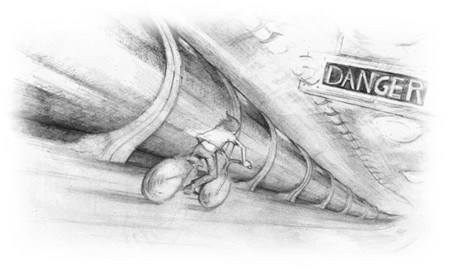
One of the most interesting things about reading a novel like Brainwalker is figuring out where the science ends and the story begins. Every science fiction and fantasy story combines elements of reality and imagination; the best ones ground imagination in a foundation of reality that lets the story soar. For Brainwalker, it all comes down to one simple idea: that Bernard’s mind can be elsewhere than his body. For new readers, that’s a hard idea to swallow. Or is it?
Several quantum mechanical theories support the idea that Bernard’s mind can exist apart from his body. Scientists at the University of Bonn in Germany recently demonstrated that atoms can actually be in two places at the same time. What the scientists did was take two sets of optical tweezers and play tug of war with an atom.
In classical physics the atom would go in one direction or the other, but according to quantum mechanics it would have an equal chance of being in both places at once. They did the measurements and that’s exactly what happened: the atom was in two places at once. Right now it can only be seen at the atomic level, which is much smaller than the level of the story, but it does give a way for Bernard to be both inside and outside the Brainiverse at the same time.
The other way you can look at it is what’s called mind-body dualism. That’s the idea that the mind is more than just the brain, that it’s something separate that controls the body through the brain. Naturally, if that’s true then of course Bernard’s mind can leave his body to enter the Brainiverse, and he doesn’t even have to be in two places at once. The two parts of him just go their separate ways. It sounds simple enough, but how plausible is it?
One of the key features of quantum mechanics is that the Universe always waits as long as possible before making up its mind. In other words, quantum mechanics tells us that the prize is behind both doors until you open one to find out. In other words, quantum mechanics requires an outside observer who can find out which door hides the prize. What makes it even more interesting is quantum mechanics is non-local, it doesn’t care about distance. No matter how far apart the two doors are, opening one affects both.
Where dualism comes in is in the nature of the observer and how observing something determines what happens. That means that observing something is a mental phenomenon with a physical effect; your mind changing the world. If this is a physical effect, then observing something should change your brain; if it doesn’t change your brain, then your mind must be separate from your brain, and that would let Bernard’s mind enter the Brainiverse.
A single explanation would be simple, but that’s not how quantum mechanics works. You have to open the door, or jump in the wormhole, first. Only then can you find the right answer, and sometimes there’s more than one.
May 14, 2016
What’s a holon?
Holons are the inhabitants of the Brainiverse, the Mindbrain universe. A Holon is a being, but it’s also part of a larger being. So Holons are part of neurons, and neurons are parts of a brain, which is part of Bernard’s dad, which is part of a world. And this world is part of a galaxy, etc.
All levels influence each other. Our cells influence our life. We influence the life of the Earth. As for the Holons, they influence the life of our neurons. But it also goes the other way. Floyd (Bernard’s dad) influences his neurons, and the Holons who live inside it.
Even though the Holons from Intuit accept the idea that everything in their world is a part of something bigger, only the Telamons are fully aware of the holonic nature of the universe. And only they understand that wormholes are a path from one level of the holonic order to another.
The Telamons of the Darks.
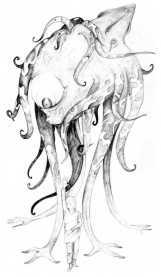 Telamons are prehistoric creatures of the Brainiverse. They lived millions of tides ago, during the Crescer era, and were at the time the only known inhabitants of this world. Telamons are thought to have disappeared soon after the appearance of holons. Occasionally, there have been reports that at high tide, some Telamons have been spotted at the edge between the upper and the lower seas.
Telamons are prehistoric creatures of the Brainiverse. They lived millions of tides ago, during the Crescer era, and were at the time the only known inhabitants of this world. Telamons are thought to have disappeared soon after the appearance of holons. Occasionally, there have been reports that at high tide, some Telamons have been spotted at the edge between the upper and the lower seas.
May 13, 2016
The brain inhabited?
Yeah right… Aliens in outer space, fine. But people inside our brain? Come on! Well, so was Bernard skeptical until he found himself inside… his father’s brain. There, he found out that the brain hosts a whole array of life forms. Chief among them are the Holons, who like to live in the very heart of our nerve cells. Frankly, they could care less about us, because they’re not even aware of our existence. But what if what they did influence our thoughts somehow?
The post The brain inhabited? appeared first on Brainwalker.


